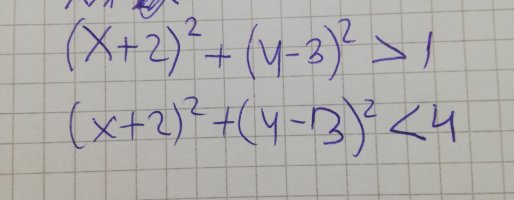You are using an out of date browser. It may not display this or other websites correctly.
You should upgrade or use an alternative browser.
You should upgrade or use an alternative browser.
Circular ring
- Thread starter Loki123
- Start date
BigBeachBanana
Senior Member
- Joined
- Nov 19, 2021
- Messages
- 2,277
You're doing it again. The full and complete question, please.
the question was:You're doing it again. The full and complete question, please.
which locus is this?
i thought it was a circle because it fits it shape and could easily just equal 3 or 2, or something in between 1 and 4. However, apparently it's a circular ring bc it's bigger than 1 and smaller than 4. I am very confused about it. Circular ring is, if i am not mistaken, two circles, not connected. So how can it be a locus? Or is it wrong that I view locus as one line.the question was:
which locus is this?
The Highlander
Senior Member
- Joined
- Feb 18, 2022
- Messages
- 1,196
I was about to post (before I saw the later post about the question asking for the "locus"):-Apparently since this equation is bigger than 1 and smaller than 4, it makes a circular ring. How?
View attachment 32166
As I'm sure you are aware, the equation of a circle may be written as:-
\(\displaystyle (x-a)^2+(y-b)^2=r^2\)
where \(\displaystyle (a, b)\) represents the centre of the circle, and \(\displaystyle r^2\) is the radius.Therefore, if the values of the the two expressions (>1 & <4) are different they will form an annulus (your "circular ring"?) or, if both have the same value
(in the range: 1< that value <4), they will just form a circle.
However, having now seen more of the "question", I would suggest that, perhaps, you are expected to calculate the Area of the annulus (ie: the area between the two curves) when the expressions are set to:
\(\displaystyle (x+2)^2+(y-3)^2=1\)
and
\(\displaystyle (x+2)^2+(y-3)^2=4\) ?
I may well be wrong on that, of course, but I'm sure BBB (or other) will confirm or comment further.and
\(\displaystyle (x+2)^2+(y-3)^2=4\) ?
Last edited:
thank you. I am not supposed to calculate anything I am just supposed to say what locus it represents.I was about to post (before I saw the later post about the question asking for the "locus"):-
As I'm sure you are aware, the equation of a circle may be written as:-
\(\displaystyle (x-a)^2+(y-b)^2=r^2\)where \(\displaystyle (a, b)\) represents the centre of the circle, and \(\displaystyle r^2\) is the radius.
Therefore, if the values of the the two expressions (>1 & <4) are different they will form an annulus (your "circular ring"?) or, if both have the same value
(in the range: 1< that value <4), they will just form a circle.
However, having now seen more of the "question", I would suggest that, perhaps, you are expected to calculate the Area of the annulus when the expressions are set to:
\(\displaystyle (x-a)^2+(y-b)^2=1\)I may well be wrong on that, of course, but I'm sure BBB (or other) will confirm or comment further.
and
\(\displaystyle (x-a)^2+(y-b)^2=4\) ?
The Highlander
Senior Member
- Joined
- Feb 18, 2022
- Messages
- 1,196
I see, in that case I would wait for someone else to comment on my suggestion before submitting it as your 'answer' because I'm not at all certain that it's correct, lol.thank you. I am not supposed to calculate anything I am just supposed to say what locus it represents.
Maybe someone else will have a better suggestion. ?
D
Deleted member 4993
Guest
Plot it and it will jump out and bite you if you are not careful!!thank you. I am not supposed to calculate anything I am just supposed to say what locus it represents.
ikr, it already bit me two timesPlot it and it will jump out and bite you if you are not careful!!
okay got it!You need two concentric circles [imath](x+2)^2+(y-3)^2=1~\&~(x+2)^2+(y-3)^2=4[/imath] SEE HERE
The set of points between the two circles is what you want.
Note that no one of those points is on either circle.

